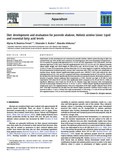Diet development and evaluation for juvenile abalone, Haliotis asinina Linne: Lipid and essential fatty acid levels
Share
Abstract
Experiments on diet development and evaluation for juvenile abalone, Haliotis asinina focusing on lipid and essential fatty acid (EFA) levels were conducted. Six isonitrogenous diets were formulated in Experiment 1 (E1) to contain 27% protein with lipid levels at 0, 2, 4, 6, 8, and 10%. Experiment 2 (E2) (EFA levels), used the optimum lipid level (3.59%) in E1 with EFA supplementation of 0.0, 0.2, 0.4, 0.8, and 1.6%. Abalone juveniles [mean initial weight and shell length of 0.60 plus or minus 0.07g and 14.70 plus or minus 0.12mm (E1)], [0.60 plus or minus 0.16g and 15.30 plus or minus 0.73mm (E2)] respectively, were fed these diets at 2-5% body weight in 3 replicates. Feeding trials in 90days/experiment evaluated growth, survival, feed conversion ratio (FCR) and fatty acid composition in abalone tissues. Results showed significantly higher growth rates (ANOVA P<0.05) with abalone fed diets with lipid levels of 2.2%, 3.6%, and 6.1% compared with those containing lipid levels of 7.6% and 9.8%. Abalone fed the lipid-free diet showed significantly the lowest growth rate among treatments. Break point analysis as a function of growth, showed optimum lipid requirement at 3.59%. Survival was high at 95-99% in both experiments. FCR values for D3 and D4 were significantly better compared to D2, D5 and D6 (E1) while no significant differences were found for D2-D6 for E2. Abalone body lipid increased with corresponding increase in dietary lipid. Addition of 18:2n, 18:3n3, and n3 HUFA showed significant improvement in weight gains up to 1.6% supplementation. Fatty acid composition of the lipid samples reflected those of the diets. Total lipid of abalone fed the lipid-free diet showed higher monoenes. Addition of EFA resulted in an increase in both n3 and n6 fatty acids. Lipid incorporation at 3.6% using a 1:1 ratio of CLO and SBO with EFA supplementation (1.6%) is best in juvenile abalone diet formulation.
Suggested Citation
Bautista-Teruel, M. N., Koshio, S. S., & Ishikawa, M. (2011). Diet development and evaluation for juvenile abalone, Haliotis asinina Linne: Lipid and essential fatty acid levels. Aquaculture , 312(1-4), 172-179. https://doi.org/10.1016/j.aquaculture.2011.01.004
Subject
Collections
- AQD Journal Articles [1249]

